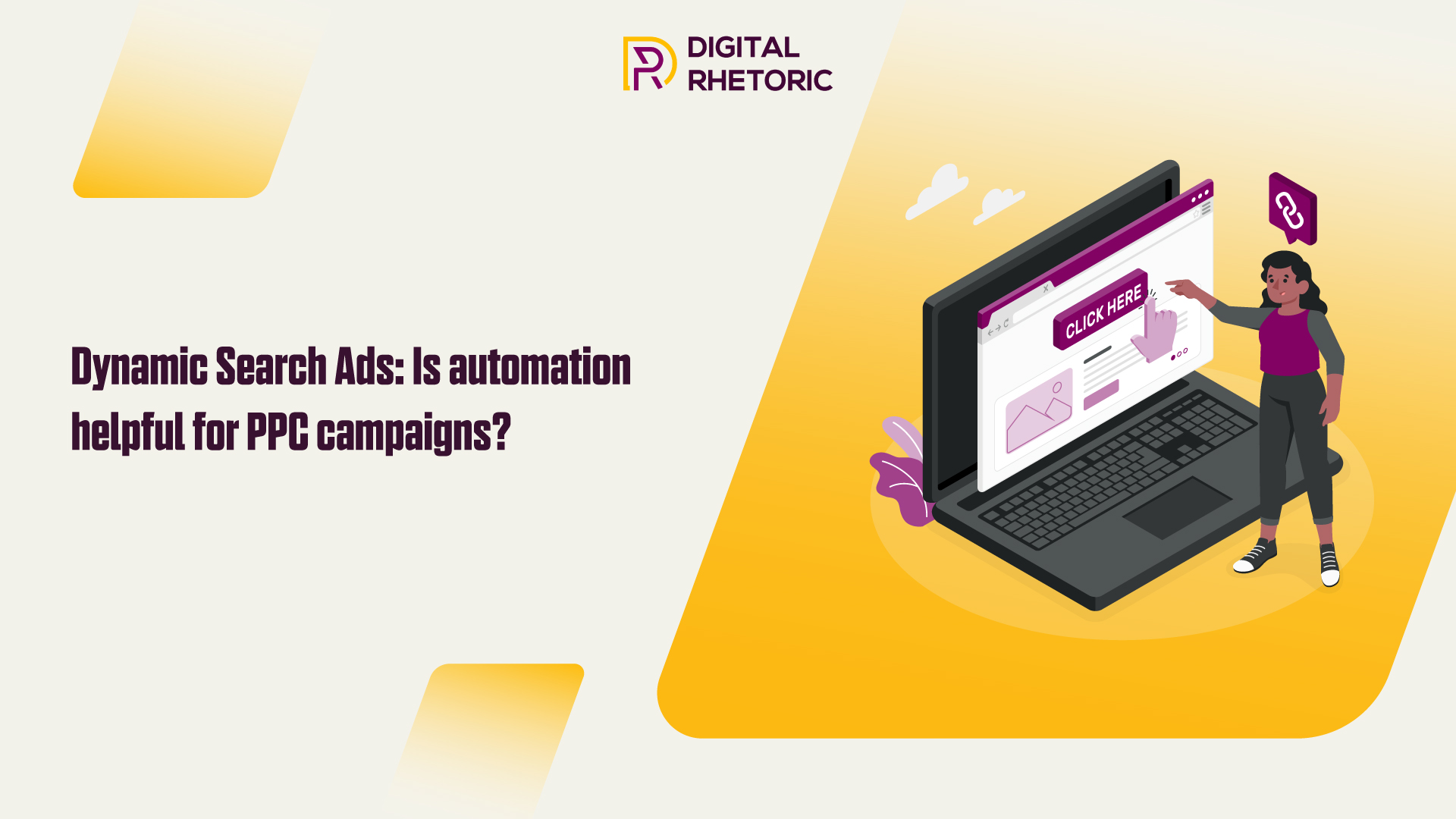
Dynamic Search Ads (DSAs) have emerged as a dynamic component in PPC (Pay-Per-Click) campaigns, redefining the way businesses reach their target audience. These ads, driven by automation, offer a fresh approach to online advertising, emphasizing efficiency and flexibility. By automatically generating ad headlines and dynamically matching them to relevant search queries, DSAs are a game-changer for those seeking to optimize their digital marketing efforts. In this blog, we delve into the multifaceted world of DSAs, examining their benefits, drawbacks, and the role of automation in shaping successful PPC campaigns. Whether you’re new to the world of DSAs or a seasoned pro, there’s always more to explore in the realm of digital advertising. Visit https://digitalrhetoric.in/ to stay informed and up-to-date on the latest trends and insights in the industry.
Automation in PPC campaigns can be a double-edged sword, offering various advantages and some drawbacks. Here’s a brief overview of the pros and cons:
Pros:
- Time Savings: Automation reduces the need for manual monitoring and adjustments, freeing up time for strategy development and creativity.
- Efficiency: Automated systems can quickly analyze data and make real-time adjustments, ensuring optimal performance.
- Consistency: Automation maintains campaign consistency, minimizing the risk of human errors.
- Cost-Effective: Over time, automation can lead to cost savings by optimizing bids and targeting.
Cons:
- Lack of Personalization: Fully automated campaigns may lack the personal touch that human strategists can provide.
- Learning Curve: Implementing automation requires a learning curve, and initial setup can be complex.
- Limited Adaptability: Automation may not always adapt well to sudden market changes or unforeseen events.
- High Initial Costs: Setting up automated systems can be costly.
Incorporating automation should be a strategic decision, weighing the benefits against the potential limitations to ensure it aligns with campaign goals and resources.
Dynamic Search Ads (DSAs) offer a range of targeting options, allowing advertisers to focus on specific keywords, pages, or products. Automation plays a pivotal role in optimizing ad delivery within these parameters. PPC automation software utilizes machine learning algorithms to analyze user behavior, search patterns, and website content in real time. This data-driven approach ensures that DSAs are displayed to the most relevant audience, maximizing click-through rates and conversions. By dynamically adapting to user intent and website changes, automation optimizes ad delivery, enhancing the effectiveness of PPC campaigns and improving overall ROI. Learn more about effective PPC strategies at https://digitalrhetoric.in/.
| Challenges and Drawbacks of Automation in PPC | Potential Implications |
| Limited Creativity and Personalization | While automation is data-driven, it may lack the ability to create unique, tailored ad copy or landing pages. |
| Inaccurate Automated Decision-Making | Algorithms can make mistakes, leading to irrelevant ads or incorrect bid adjustments. |
| Dependence on Historical Data | Automation relies on past performance, which can be limiting for new campaigns or rapidly changing industries. |
| Reduced Control Over Campaigns | Complete automation may limit the advertiser’s ability to make real-time adjustments to campaigns. |
| Increased Competition for High-Performing Keywords | Automated bidding can drive up costs for competitive keywords, affecting budget allocation. |
| Risk of Overspending or Budget Depletion | Lack of manual oversight may result in unintended budget exhaustion or excessive spending. |
Balancing the benefits of automation with these potential challenges is essential for successful PPC campaigns.
Tips for implementing and managing DSAs effectively with or without automation.
- Keyword Research: Even with automation, conduct thorough keyword research to ensure relevant search terms are included.
- Ad Customization: Create compelling ad copy that aligns with the website content for better click-through rates.
- Negative Keywords: Regularly update negative keyword lists to exclude irrelevant search queries.
- Landing Page Optimization: Ensure landing pages are well-structured, fast-loading, and mobile-friendly.
- Ad Extensions: Utilize ad extensions to provide more information and improve ad quality.
- Bid Management: Monitor bids, especially for high-converting keywords, to achieve a balanced ROI.
- Regular Review: Periodically assess campaign performance, making adjustments as needed to improve results.
- Quality Score: Focus on improving Quality Score, as it impacts ad positioning and costs.
- Competitor Analysis: Keep an eye on competitors and their strategies in the auction.
- A/B Testing: Experiment with different ad elements and landing pages to identify what resonates with your audience.
Balancing manual oversight with automation can lead to effective DSA campaigns.
The impact of Google’s machine learning and AI on the future of PPC campaigns.
Google’s machine learning and AI are transforming the future of PPC campaigns. With PPC automation software, these technologies enable precise ad targeting, ad copy optimization, and bid adjustments. Machine learning algorithms analyze vast amounts of data in real time, adapting campaigns for optimal performance. This not only saves time but also enhances the efficiency of PPC efforts. As AI continues to evolve, it promises more advanced features like predictive analytics and audience segmentation, allowing businesses to reach their target audiences with greater accuracy. Embracing these advancements is crucial for staying competitive and achieving the best ROI in the ever-evolving landscape of digital advertising.
Strategies for monitoring and optimizing DSAs to maximize ROI.
- Regularly review search term reports to identify irrelevant or costly keywords.
- Use negative keywords to filter out irrelevant traffic.
- Experiment with ad copy variations to find what resonates with your audience.
- Continuously adjust bids based on performance data.
- Monitor landing page quality and relevance.
- Leverage ad extensions to provide additional information.
- A/B test different ad formats.
- Utilize ad scheduling to reach your audience at the most opportune times.
- Consider the seasonality and trends of your industry to adjust your strategy accordingly.
- Stay updated with Google Ads’ latest features and best practices for DSAs.
Balancing automation with manual control in PPC campaigns.
Balancing automation and manual control in PPC campaigns is crucial for a successful digital marketing strategy. While automation streamlines routine tasks and improves efficiency, manual oversight ensures strategic control and adaptability. Finding the right equilibrium involves setting up automated rules, such as bidding strategies, while continuously monitoring and adjusting campaigns based on performance and industry trends. This hybrid approach leverages the benefits of automation while allowing human intervention to address nuances, unexpected challenges, and creative optimizations. Striking the right balance maximizes the effectiveness of PPC campaigns, combining the power of technology with human expertise.
Conclusion
In the ever-evolving landscape of digital marketing, automation in PPC, like Amazon PPC automation, is a double-edged sword. It offers unparalleled efficiency, freeing up time for strategic thinking and creative endeavors. However, its success relies on a balance that incorporates human insights and adaptability.
As technology advances, the role of automation in PPC continues to expand. Google’s machine learning and AI are reshaping the future of advertising. While the potential is vast, it’s essential to remember that the effectiveness of automation ultimately depends on how it’s harnessed.
The key is to leverage automation where it excels – in data analysis, bidding optimization, and routine tasks – while preserving the human touch for strategy, creativity, and addressing unforeseen challenges. A hybrid approach ensures campaigns remain agile, responsive, and in tune with changing consumer behavior.
To explore more about the dynamic realm of digital marketing and PPC automation, visit Digital Rhetoric today and stay ahead in the digital advertising game.

